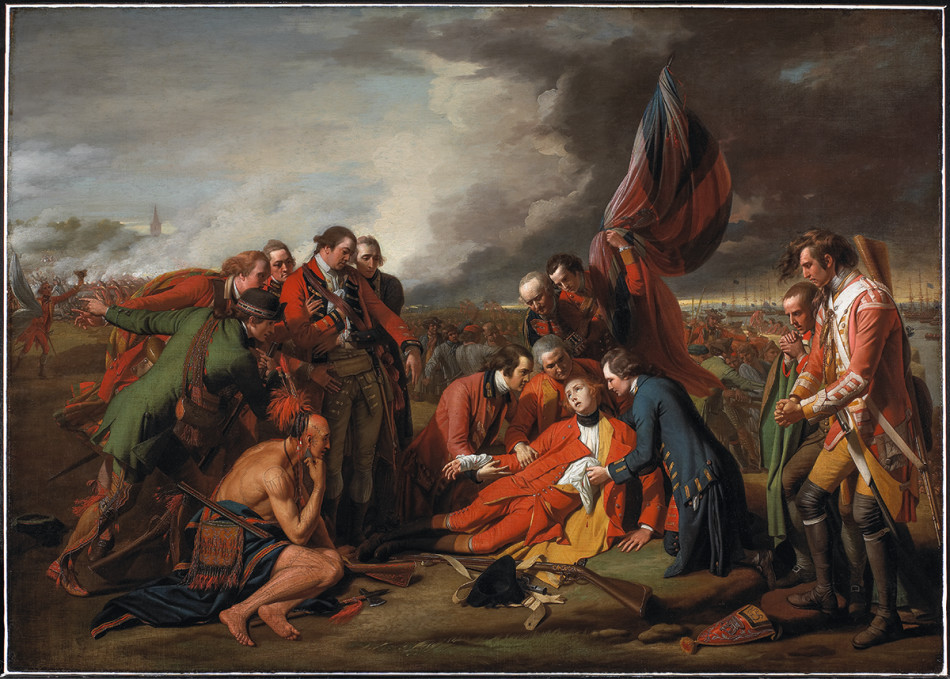Benjamin West: a very contemporary artist
Benjamin West: a very contemporary artist
By Loyd Grossman
Published 7 October 2015
As his biography of Benjamin West PRA is published, Loyd Grossman reveals how this founding member of the Academy broke with the past like no other artist of his era.
-
From the Autumn 2015 issue of RA Magazine, issued quarterly to Friends of the RA.
Benjamin West’s trajectory was steep. Born to a modest family close to the Western frontier of Pennsylvania in 1738, he was – thanks to rich Philadelphia patrons – the first American artist to embark on the Grand Tour of Italy, after which he arrived in London aged 25. A mere five years later, he was with the greatest artists in the land, petitioning George III to create the Royal Academy. By the time of his death in 1820, he had been President of the Royal Academy for more than 25 years and was the most famous artist in the English speaking world, but within a generation, West was derided and heading towards the critical obscurity from which he has only recently emerged.
Certainly West’s rapid change of status from outsider to Establishment grandee roused some hostility, but perhaps more importantly West was just too hard to place. He had neither the relaxed elegance of Thomas Gainsborough RA nor the swagger and intellectual pretensions of Joshua Reynolds PRA. And his work, so revolutionary within the context of the eighteenth century, did not fit into the narrative of the rise of ‘modern’ art. Yet more than any other artist of his time, West gave visual expression to what it meant to be modern.
Early 18th-century Europe was torn apart by a bitter intellectual war that Jonathan Swift called The Battle of the Books, but is more often known as the Quarrel Between the Ancients and the Moderns. While it may seem trivial to our minds, the dispute, which revolved around whether it was possible to equal or even surpass the artistic and intellectual achievements of the Greeks and Romans, was a major crisis of confidence in an 18th-century world that was bewildered by multiple social, political and economic revolutions. In a time where classical models of art and literature were venerated, it took some boldness to proclaim as James Boswell did: “I do sincerely think that this age is better than ancient times.”
The problem of reconciling optimism about the present with reverence for the past was particularly acute for 18th-century artists who aspired to excel in the most elevated genre of art, history painting, which took its subject matter from the Bible, mythology and the ancient world: subject matter with which artists themselves, and more importantly the public, were becoming bored. William Hogarth was not alone in wishing that painting might “be made more entertaining and more useful than the eternal blazonry, and tedious repetition of hackneyed, beaten subjects, either from the Scriptures, or the old ridiculous stories of heathen gods.” It was West’s particular genius to use the exalted visual language of history painting to celebrate a contemporary event in The Death of General Wolfe, the popular hit of the 1771 Royal Academy exhibition and subsequently one of the most widely reproduced images of the century.
The death of General James Wolfe, killed at the moment of British victory over the French at the Battle of Quebec in 1759, was a particularly emotive subject. Even 12 years after his death, Wolfe remained the military hero and Imperial martyr par excellence. His death had already been painted and exhibited twice, first by George Romney and secondly by Edward Penny. But West raised the death of the young officer from the mere depiction of a current event to the status of a universal drama by choosing to paint it in the traditional form of a lamentation over the dead Christ. In one spectacular artistic coup, West unequivocally stated that the events of the present were as laudable and inspirational as any from the Biblical, ancient or mythological past.
The effect was electrifying. In spite of the reservations of many – Reynolds warned West that his effort to paint Wolfe’s death as a contemporary event would cause “repulse or ridicule” – Wolfe was a triumph with a public who were no longer prepared to keep looking over their shoulders to the past for examples of greatness. If being modern is, in the phrase of the French philosopher Michel Foucault, “the will to ‘heroize’ the present”, then Wolfe was a giant step on the road to modernity.
But West was no one-trick pony. It takes more than a handsome face and an agreeable manner to get from the back woods of Pennsylvania to the State Rooms of Windsor Castle. Throughout his career West was a restless innovator: as a young man at the forefront of neo-classicism and as an old man working in the language of the Romantics. Reconsidering Wolfe and his many other achievements, it’s time to honour the second President of the Royal Academy.
-

Benjamin west PRA, The Death of General Wolfe, 1770.
Oil on canvas. 152.6 x 214.5 cm. Transfer from the Canadian War Memorials, 1921 (Gift of the 2nd Duke of Westminster, England, 1918), National Gallery of Canada, Ottawa. Photo © National Gallery of Canada.
-
Benjamin West and the Struggle to be Modern, by Loyd Grossman, £35 hardback, is published by Merrell on 8 October 2015.
Loyd Grossman is Chairman of the Churches Conservation Trust and Deputy Chairman of the Royal Drawing School.
-
-
Enjoyed this article?
Become a Friend to receive RA Magazine
As well as free entry to all of our exhibitions, Friends of the RA enjoy one of Britain’s most respected art magazines, delivered directly to your door. Why not join the club?

-





